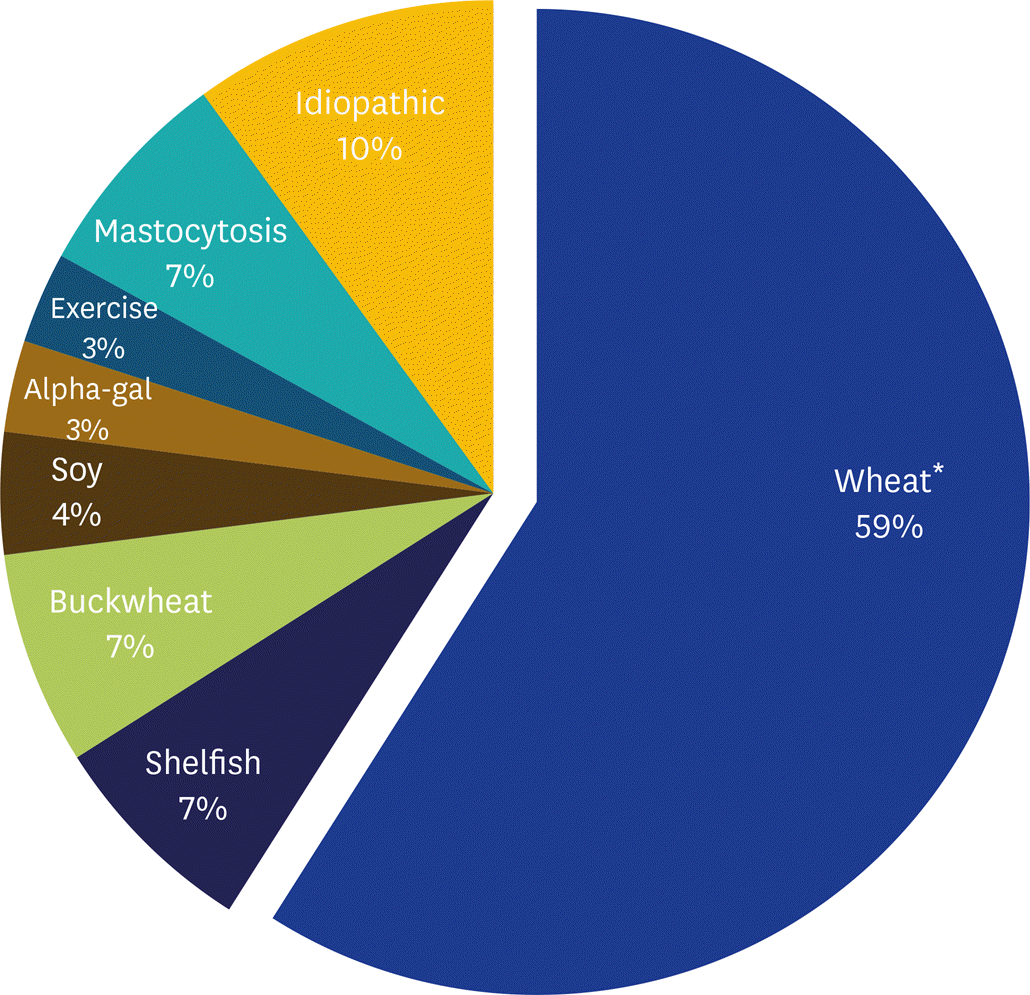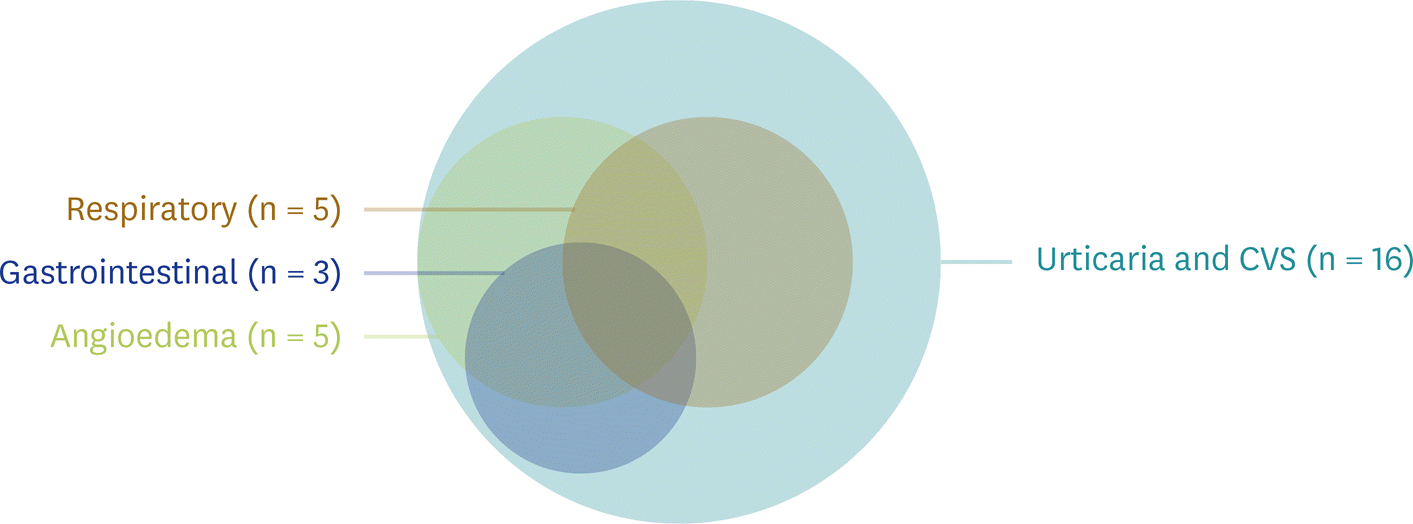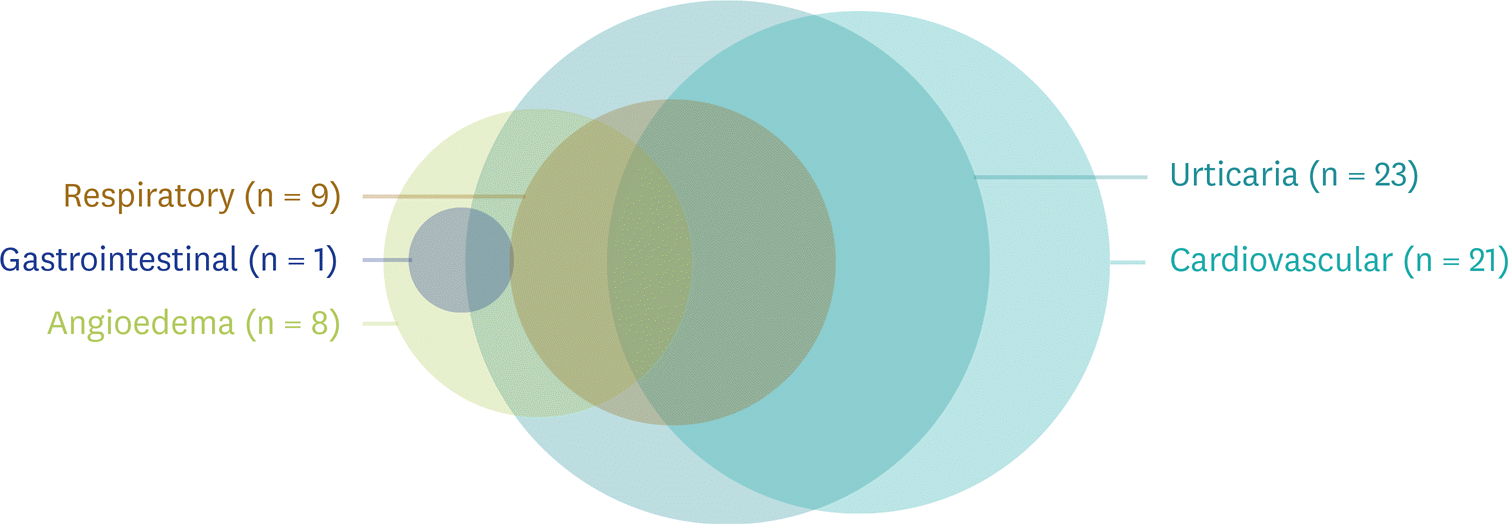Abstract
Background
Omega-5-gliadin (O5G) allergy, also known as wheat-dependent exercise-induced anaphylaxis, is commonly reported in the Western, but not Asian, populations. Although significant differences in O5G allergy presentation across different populations are likely but there have been no previous reports on this important topic.
Objective
To report on the prevalence and characteristics of O5G allergy in Hong Kong (HK) compared with the United Kingdom (UK).
Methods
O5G allergy patients attending Queen Mary Hospital (HK cohort), and Guy's and St Thomas' Hospital, London (UK cohort) were studied and compared.
Results
A total of 46 O5G allergy patients (16 HK; 30 UK) were studied. In the HK cohort, 55% of all patients previously labeled as “idiopathic anaphylaxis” were diagnosed with O5G allergy. Exercise was the most common cofactor in both cohorts, followed by alcohol and nonsteroidal anti-inflammatory drugs (NSAID). A higher proportion of the HK cohort reported NSAID as a cofactor (13% vs. 0%, p = 0.048). In the HK cohort, more patients presented with urticaria and cardiovascular manifestations (100% vs. 77%, p = 0.036; 100% vs. 70%, p = 0.015, respectively); the range of presentation was more diverse in the UK cohort. In HK fewer patients adhered to wheat avoidance (50% vs. 87%, p = 0.007) and more patients avoided cofactors only (44% vs. 10%, p = 0.008).
Go to : 
References
1. Morita E, Kunie K, Matsuo H. Food-dependent exercise-induced anaphylaxis. J Dermatol Sci. 2007; 47:109–17.

2. Kennard L, Thomas I, Rutkowski K, Azzu V, Yong PFK, Kasternow B, Hunter H, Cabdi NMO, Nakonechna A, Wagner A. A multicenter evaluation of diagnosis and management of omega-5 gliadin allergy (also known as wheat-dependent exercise-induced anaphylaxis) in 132 adults. J Allergy Clin Immunol Pract. 2018; 6:1892–7.

3. Scherf KA, Brockow K, Biedermann T, Koehler P, Wieser H. Wheat-dependent exercise-induced anaphylaxis. Clin Exp Allergy. 2016; 46:10–20.

4. Lee TH, Leung TF, Wong G, Ho M, Duque JR, Li PH, Lau CS, Lam WF, Wu A, Chan E, Lai C, Lau YL. The unmet provision of allergy services in Hong Kong impairs capability for allergy prevention-implications for the Asia Pacific region. Asian Pac J Allergy Immunol. 2019; 37:1–8.
5. Kushimoto H, Aoki T. Masked type I wheat allergy. Relation to exercise-induced anaphylaxis. Arch Dermatol. 1985; 121:355–60.

6. Li PH, Lau CS. Immunology in food allergy and anaphylaxis. Hong Kong Bull Rheum Dis. 2017; 17:26.

7. Lee AJ, Thalayasingam M, Lee BW. Food allergy in Asia: how does it compare? Asia Pac Allergy. 2013; 3:3–14.

8. Hospital Authority. Hospital Authority annual report 2017-2018 [Internet]. Hong Kong: Hospital Authority;2018. [cited 2019 Dec 9]. Available from:. http://www.ha.org.hk/ho/corpcomm/AR201718/PDF/HA_Annual_Report_2017-2018.pdf.
9. Muraro A, Roberts G, Worm M, Bilò MB, Brockow K, Fernández Rivas M, Santos AF, Zolkipli ZQ, Bellou A, Beyer K, Bindslev-Jensen C, Cardona V, Clark AT, Demoly P, Dubois AE, DunnGalvin A, Eigenmann P, Halken S, Harada L, Lack G, Jutel M, Niggemann B, Ruëff F, Timmermans F, Vlieg-Boerstra BJ, Werfel T, Dhami S, Panesar S, Akdis CA, Sheikh A. EAACI Food Allergy and Anaphylaxis Guidelines Group. Anaphylaxis: guidelines from the European Academy of Allergy and Clinical Immunology. Allergy. 2014; 69:1026–45.

10. Le TA, Al Kindi M, Tan JA, Smith A, Heddle RJ, Kette FE, Hissaria P, Smith WB. The clinical spectrum of omega-5-gliadin allergy. Intern Med J. 2016; 46:710–6.

11. Wölbing F, Fischer J, Köberle M, Kaesler S, Biedermann T. About the role and underlying mechanisms of cofactors in anaphylaxis. Allergy. 2013; 68:1085–92.

12. Matsuo H, Morimoto K, Akaki T, Kaneko S, Kusatake K, Kuroda T, Niihara H, Hide M, Morita E. Exercise and aspirin increase levels of circulating gliadin peptides in patients with wheat-dependent exercise-induced anaphylaxis. Clin Exp Allergy. 2005; 35:461–6.

13. Christensen MJ, Eller E, Mortz CG, Brockow K, Bindslev-Jensen C. Wheat-dependent cofactor-augmented anaphylaxis: a prospective study of exercise, aspirin, and alcohol efficacy as cofactors. J Allergy Clin Immunol Pract. 2019; 7:114–21.

14. Huang WY, Saver JL, Wu YL, Lin CJ, Lee M, Ovbiagele B. Frequency of intracranial hemorrhage with low-dose aspirin in individuals without symptomatic cardiovascular disease: a systematic review and meta-analysis. JAMA Neurol. 2019 May 13. [Epub].https://doi.org/10.1001/jamaneurol.2019.1120.
Go to : 
 | Fig. 1.Pie chart showing etiologies of previously labeled “idiopathic anaphylaxis” in Hong Kong (n = 29). * Out of 17/29 cases of wheat-related anaphylaxis, 16 were omega-5-gliadin allergy, and 1 was primary wheat allergy. |
 | Fig. 2.Venn diagram depicting the frequency and overlap of clinical symptoms during index reactions of omega-5-gliadin allergy patients in Hong Kong (n = 16). CVS, cardiovascular system. |
 | Fig. 3.Venn diagram depicting the frequency and overlap of clinical symptoms during index reactions of omega-5-gliadin allergy patients in United Kingdom (n = 30). |
Table 1.
Association analysis of patient characteristics, cofactors, clinical manifestations and investigation results of omega-5-gliadin allergy patients in Hong Kong (HK) and United Kingdom (UK)
| Characteristic | Combined (n = 46) | HK Cohort (n = 16) | UK Cohort (n = 30) | p value |
|---|---|---|---|---|
| Male sex | 23 (50) | 10 (63) | 13 (43) | 0.216 |
| Age of onset (yr) | 34 (16–69) | 34 (16–69) | 34 (17–69) | 0.988 |
| Chinese ethnicity | 17 (37) | 16 (100) | 1 (3) | <0.001* |
| Asthma or COPD | 4 (9) | 1 (6) | 3 (10) | 0.667 |
| Other suspected food allergies | 9 (20) | 4 (25) | 5 (17) | 0.497 |
| Chronic urticaria | 18 (39) | 6 (38) | 12 (40) | 0.869 |
| Delay in diagnosis (yr) | 2 (0–37) | 5 (0–20) | 1.5 (0–37) | 0.837 |
| Cofactors | ||||
| Exercise | 43 (94) | 16 (100) | 27 (90) | 0.191 |
| Alcohol | 13 (28) | 2 (13) | 11 (37) | 0.083 |
| NSAID | 2 (4) | 2 (13) | 0 (0) | 0.048* |
| Time between wheat ingestion and cofactor exposure (min) | 30 (0–480) | 17.5 (15–60) | 60 (0–480) | 0.079 |
| Clinical manifestations | ||||
| Urticaria | 39 (85) | 16 (100) | 23 (77) | 0.036* |
| Angioedema | 13 (28) | 5 (31) | 8 (27) | 0.742 |
| Respiratory manifestations | 14 (30) | 5 (31) | 9 (30) | 0.930 |
| Gastrointestinal manifestations | 5 (11) | 3 (19) | 1 (3) | 0.077 |
| Cardiovascular manifestations | 37 (80) | 16 (100) | 21 (70) | 0.015* |
| Investigation results | ||||
| Wheat SPT positivity | 20 (63)§ | 9 (82)† | 11 (55)‡ | 0.135 |
| Omega-5-gliadin sIgE (kU A/L) | 11.8 ± 1.65 | 12.61 ± 3.11 | 11.37 ± 1.95 | 0.738 |
| Wheat sIgE (kU A/L) | 1.69 ± 0.63 | 1.14 ± 0.40 | 2.09 ± 1.05 | 0.682 |
Table 2.
Differences between avoidance measures and recurrence rate of omega-5-gliadin allergy patients in Hong Kong (HK) and United Kingdom (UK)




 PDF
PDF ePub
ePub Citation
Citation Print
Print


 XML Download
XML Download